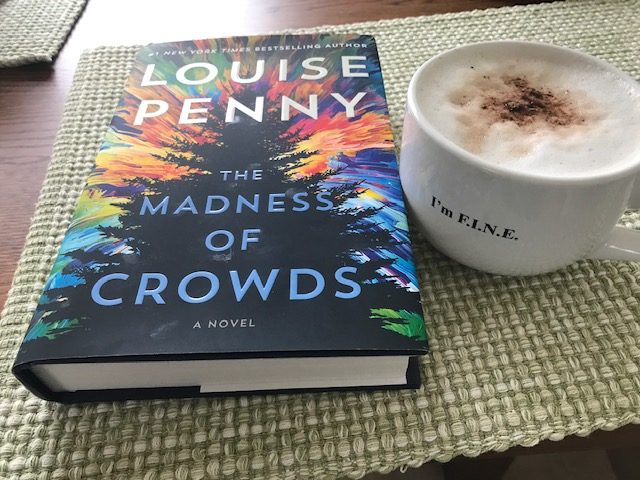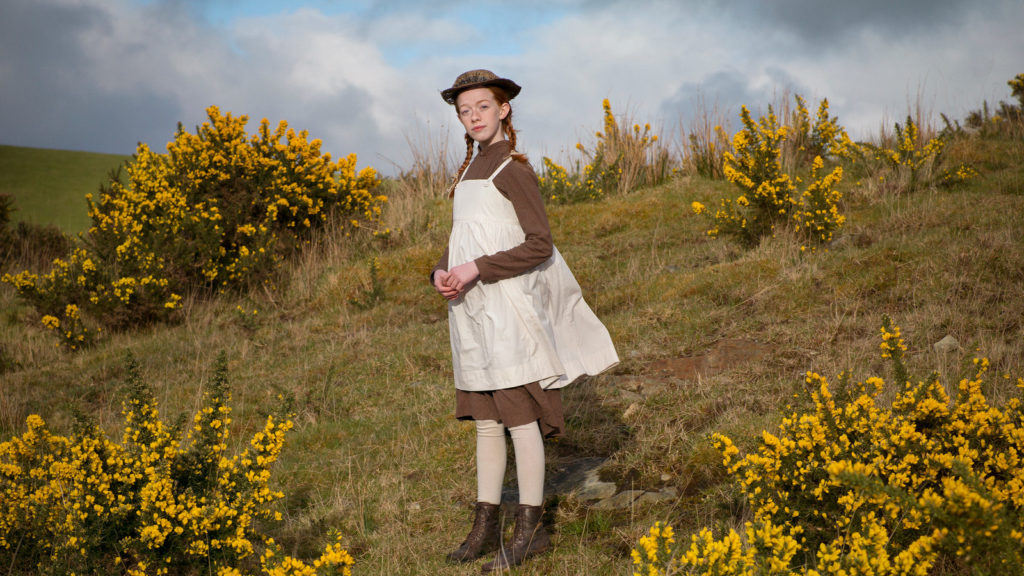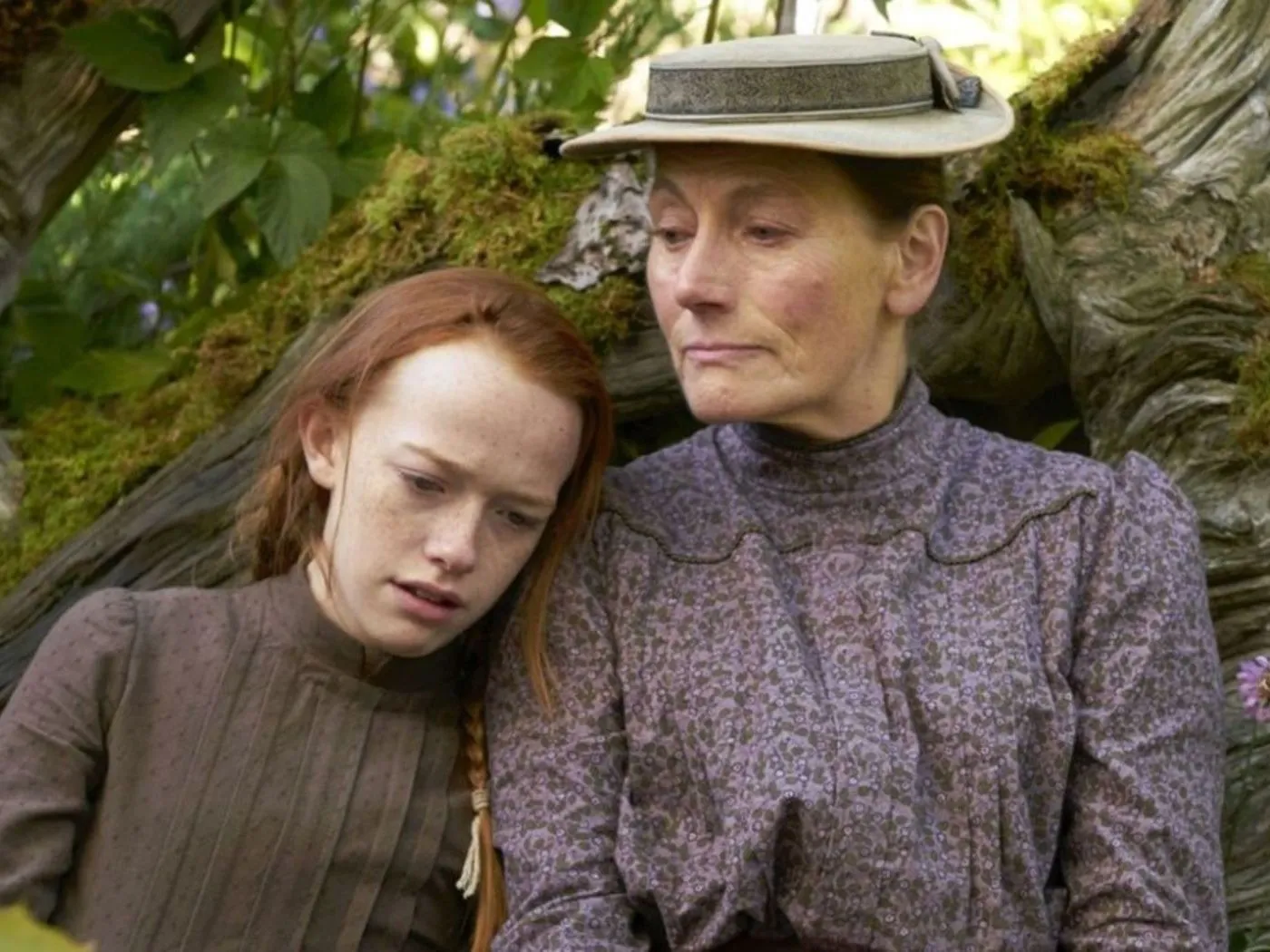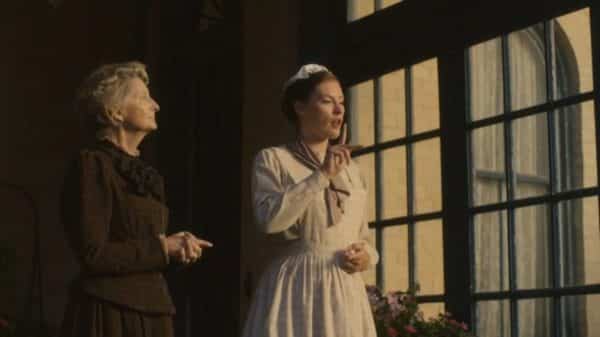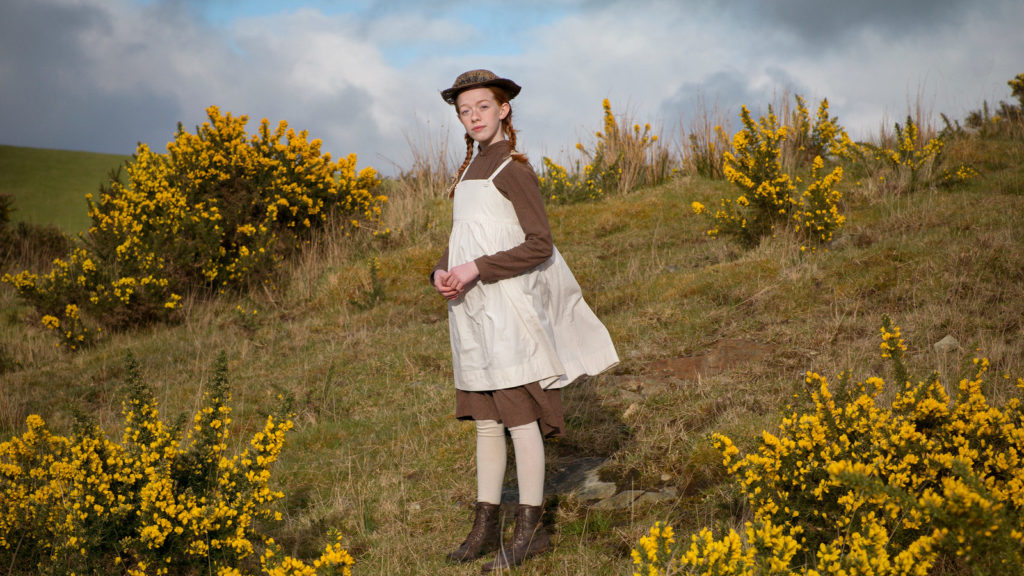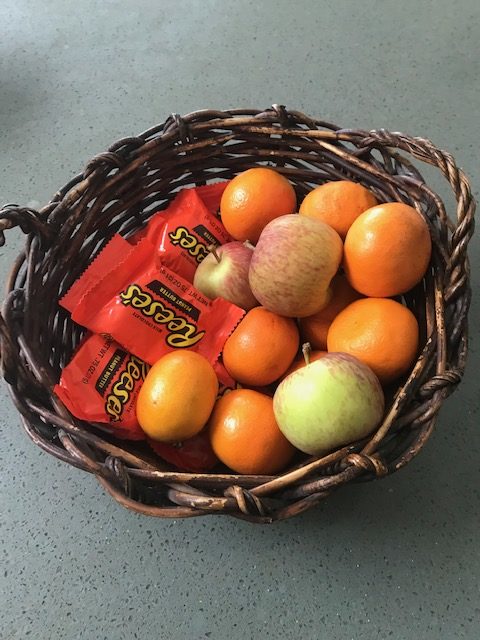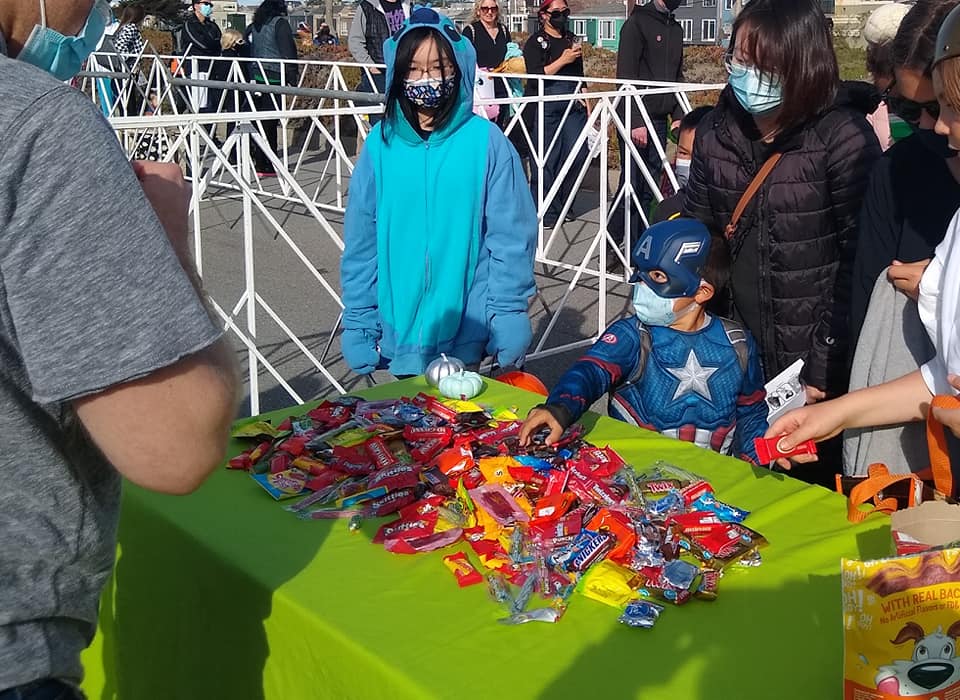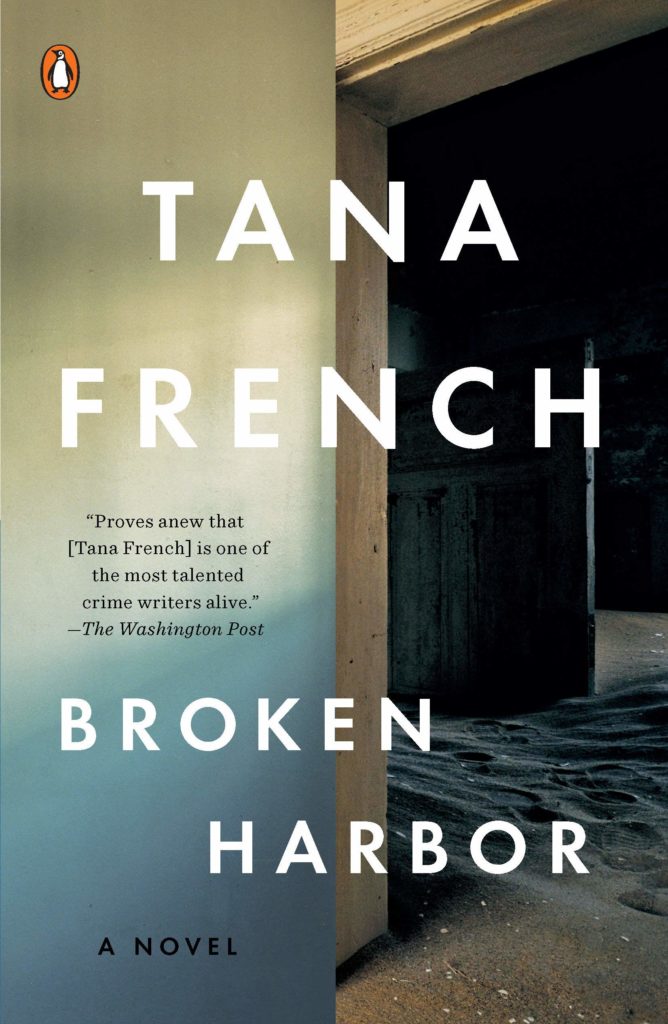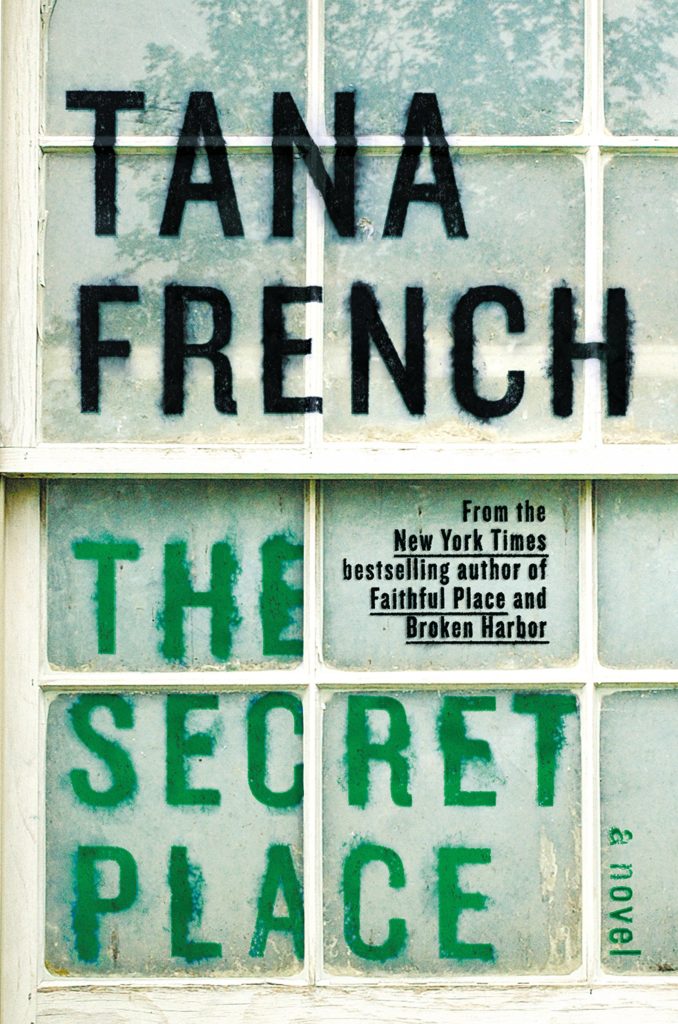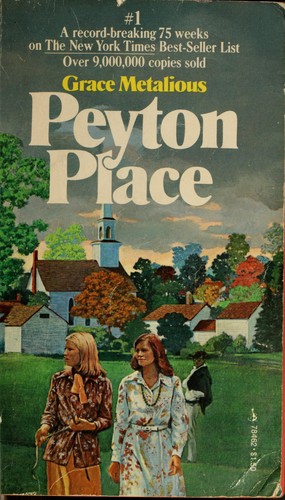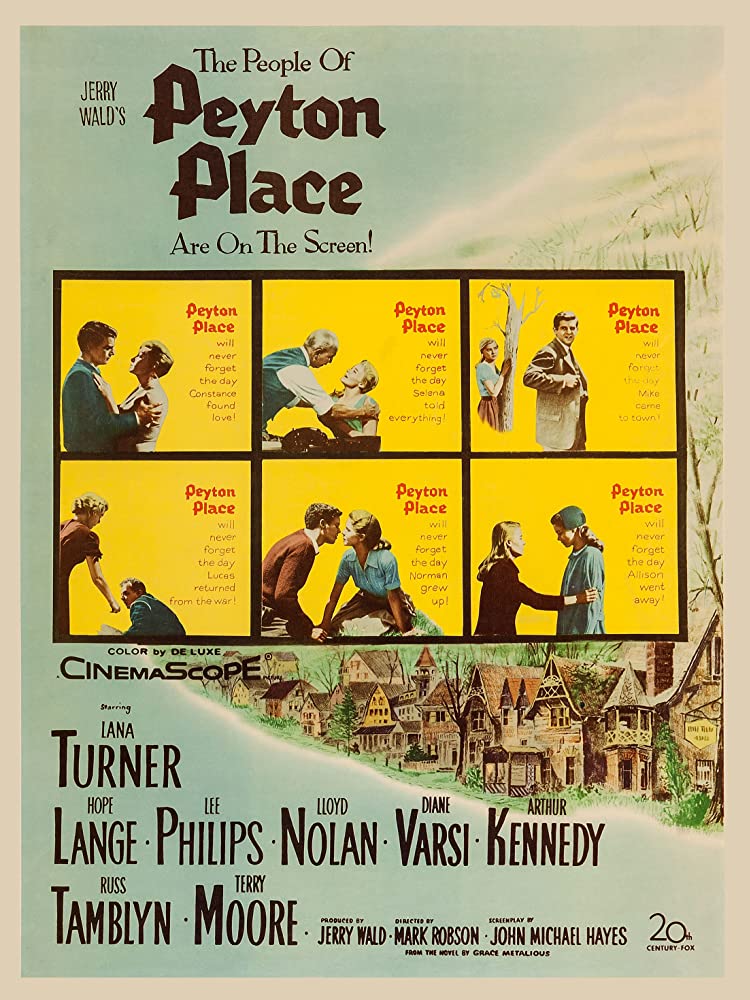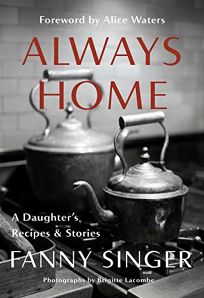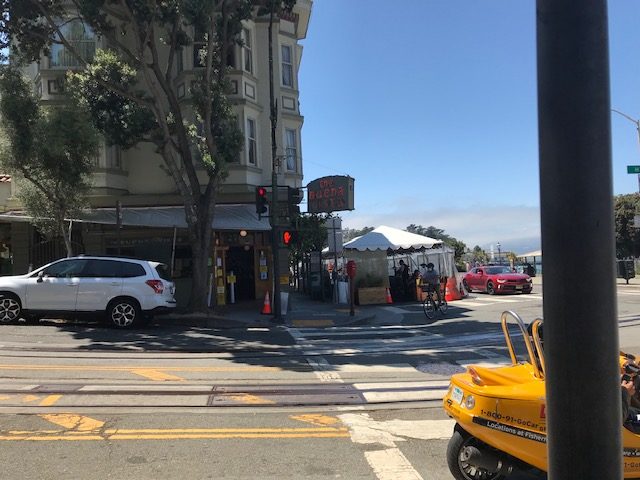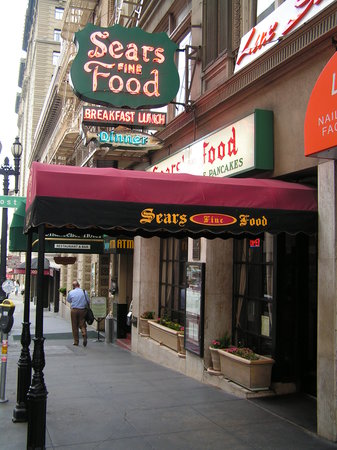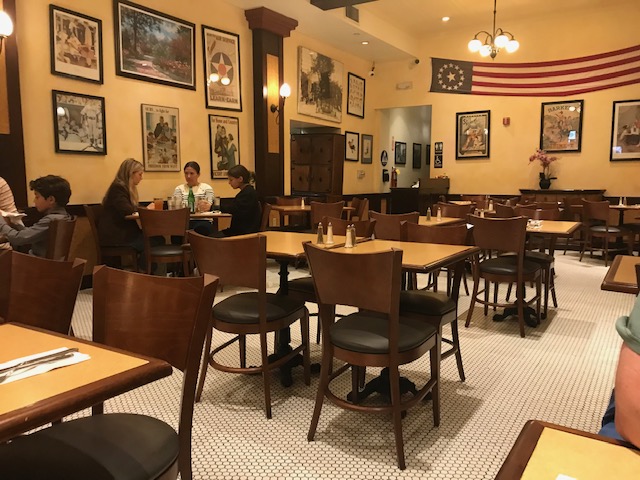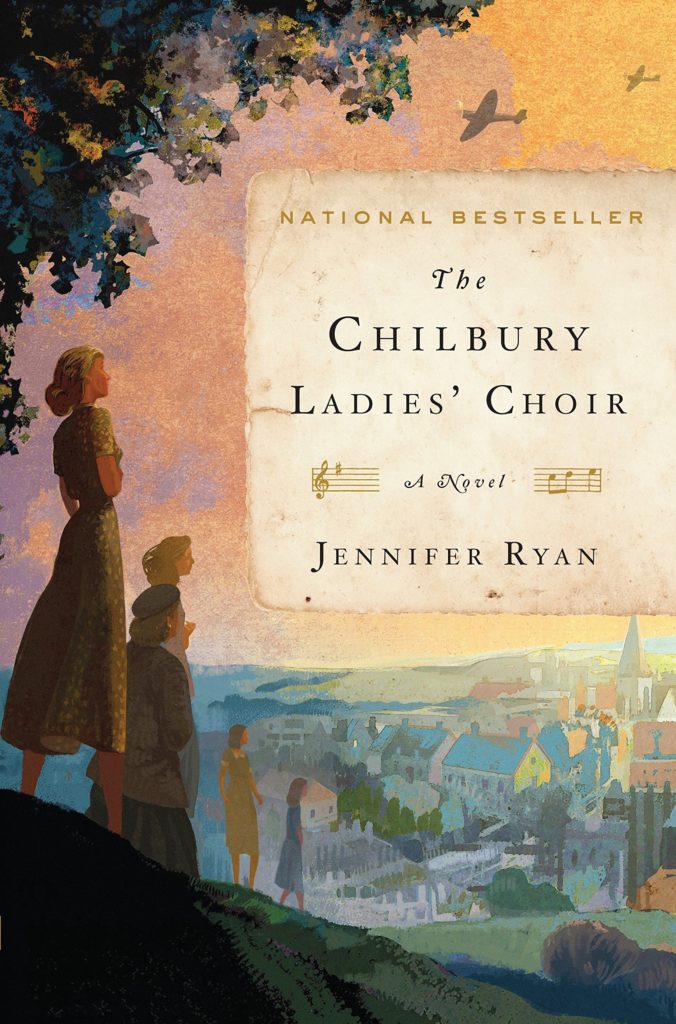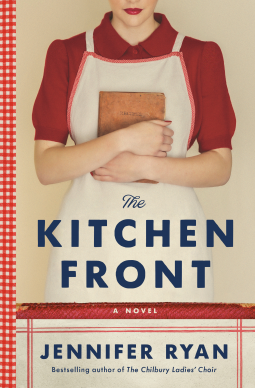The Madness of Crowds by Louise Penny
I purchased The Madness of Crowds as soon as it was released — supporting my local bookstore.
My–my, just look at those gorgeous end pages!
My reading of Louise Penny’s latest installment was accompanied with my Three Pines cup, a gift from my sister after a trip to Quebec and Brome Lake Books in Knowlton. Also a devoted Louise Penny fan, she and her husband explored the area that inspired the fictional Three Pines setting. Here’s the MAP they used from the bookstore’s website.
You Louise Penny fans already know what ” I’m F.I.N.E ” stands for, but if not; we must consult the foul mouthed, cranky poet, and one of Three Pines most colorful characters.
“I’m FINE” according to Ruth Zardo is:
- F: F#*&ed Up
- I: Insecure
- N: Neurotic
- E: Egotistical
But, as usual I digress — on to the book.
The good news is that we’re back in Three Pines with Chief Inspector Armand Gamache, Jean-Guy Beauvoir, Clara, Myrna, Gabri, Olivier, Ruth Zardo, and her muttering duck are all present and accounted for. It’s Three Pines in the winter with mugs of hot chocolate, ice skating, bonfires, and the very cold weather.
They stepped outside, and though they were braced for it, the bitter cold still stole their breaths. It scraped the flesh of their faces and made their eyes water.
The Madness of Crowds very admirably utilizes the pandemic and its aftermath as the timely plot line for this mystery. But, I overcame my initial dismay at the topic (haven’t we all had enough of this pandemic and why couldn’t Three Pines have been spared?) and started reading. Ms. Penny soon addressed our shared pandemic fatigue…
Though the pandemic was now over, it had left behind a population worn down. People were tired of being self-disciplined, of self-isolating. Of social distancing and wearing masks. They were exhausted, shell-chocked, from months and endless months of worrying about their children, their parents, their grandparents. Themselves.
After 70 pages, things came together and I started to understand that the ‘madness of crowds’ referred to the overall theme of this book — the blind devotion to misinformation which leads to unprincipled and often evil ideas.
The bad news is that this post-pandemic Three Pines world is full of harsh truths; eugenics, crowd behavior, rape and torture of women, experimental treatment of the mentally ill, failed public health policies, dementia, and most upsetting — threats to disabled children. So, be warned, The Madness of Crowds is not the escape we’ve come to depend on in Ms. Penny’s books. But, importantly, it also presents thought-provoking questions about ethics and human relationships in a post-COVID world.
Hey there, don’t worry Ms. Penny still writes with her usual empathy, insights, sensitivity, and her trademark delightful humor…
Stephen was up by then and dressed as always in a crisp shirt, sweater, and gray flannels. Ready for a board meeting, should one arise.
“She’s right”, said Myrna, turning astonished eyes on the mad poet [Ruth] at the other end of the sofa. “She was bound to be right eventually,” said Clara. “Law of averages.”
I struggled a bit with the last part of the book and its parade of red herrings. Without giving anything away, there is also a final scene, where Armand Gamache lets a gun lie in a room with suspects — waiting for it to be used. This is an antithesis to everything we know about his character.
Don’t get me wrong, The Madness of Crowds still delivers a well-written and complex mystery with the wonderful characters, and great food of Three Pines. But it also slaps the reader right across the face with humanity’s darker side.
We are seeing an evolution in Ms. Penny’s writing. She started out writing charming and cheerful Quebec mysteries set in the camelot-like setting of Three Pines. I can’t fault Ms. Penny for reflecting the news of our current times and for moving her craft into new vistas.
It’s just that I miss her old style and earlier books. I wish we had a real Gamache, whose musings on horrible behaviors could help us to understand why some chose such dreadful paths — and to help us feel less afraid.
And say “all will be well”.
Now I’m off to my annual holiday readathon, chosen from my as-yet-unread collection.
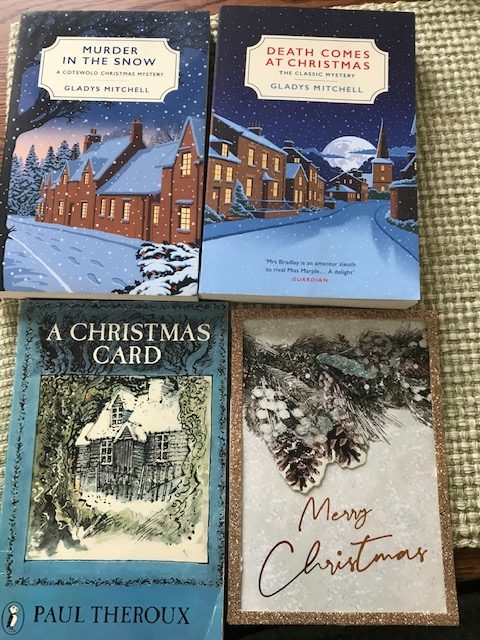
The last image is a favorite Christmas card I received — with lots of glitter and cheer.
Warning: If you love someone who is disabled, or if you lost someone you love to Covid, this book may be triggering.
Anne With an E
Normally, once Husband goes to bed, I settle into my reading nook with a book — but these days I have lots of knitting projects in progress for gifts. Especially for those friends and family in colder climes. So, this time of year I turn to television and knit instead.
A few weeks ago, starting on my fourth knitting project, I stumbled across a series on Netflix ~~
Anne With an E — based on the Anne of Green Gables books.
I must admit I never much warmed to the Anne of Green Gables books, even though my mother adored them — I’ve never shared her enthusiasm. I also found the various screen adaptations over the years one-dimensional and often annoying.
However this 2017-2020 Canadian series won me over. This is a broad retelling of a big-hearted orphan girl in a small Canadian town. By broad, I mean there are racial issues, gender inequality, sexual harassment, and even homosexual acceptance. This series aims high and wide, with diversity and acceptance as on-going themes.
Anne With an E remains set in the late 1800s, and perhaps these new story lines are a tad progressive for strict historical accuracy, but they work nevertheless, and serve as reminder that struggles for acceptance and equality are not unique to our times.
Anne survives on her ability to use her imagination as a defense mechanism and she remains generally upbeat despite the abuse in her past and the callousness of many of the grown-ups in her present. Anne’s most delightful pronouncement:
“When you are imagining, you might as well imagine something worthwhile.”
The series cast is absolutely wonderful with spot on performances — Anne is perfectly cast. Other notables include Geraldine James as Marilla
and a witty 90-year old Corinne Conley who steals every scene she’s in. (Think Maggie Smith in Downton Abby)
Anne With an E is beautifully filmed on location on Prince Edward Island — just feast your eyes.
Sadly, a planned fourth season was cancelled. Fortunately, most of the story lines were sufficiently resolved in the final episode. But others remained unresolved, including the painful one of Ka’kwet, a Mi’kmaq First Nation girl who was stolen from her tribe to be ‘assimilated’ in a strick Catholic run school.
I started watching Anne With an E with trepidation, figuring it was something to distract me while I knitted. I was pleasantly surprised and found it both engaging and absorbing. Not the least bit saccharin or one-dimensional.
Some reviewers have pegged it as a darker retelling but I say it’s richer and more compelling.
Look for Anne With an E on Netflix.
Broken Harbor by Tana French
Halloween night at our house. As with every year, we anxiously await trick or treaters, but over the years they have dwindled. And this year, none — even our favorite 5 (no I’m-almost-6!) year old didn’t get to stop by.
Our basket sat untouched by the front door .
Where was everyone? Down on the beach where the city closed the highway to traffic.
Safe and fun for all involved. No crossing streets, no cars. Tables set up by volunteers, parents, and local groups to serve treats (lots of treats) for the revelers. There were costume parades, pumpkin carving, and a photographer to capture it all. It’s the new, safer, and arguably better Halloween for everyone.
Full disclosure, we were loath to venture into the fray of sugar-frenzied kids and exhausted parents. So, I gathered these photos from our local Facebook page as evidence. (Click each to make larger – the family portrait is especially stunning.)
As night fell, we closed our curtains knowing our neighborhood little ones had a wonderful time. So what to do on a silent doorbell Halloween night? Settle in with a cup of tea and finish my book – and perhaps a Reeses (see lonely basket above).
Broken Harbor by Tana French
I’m a big fan of Tana French and am reading her Dublin Murder Squad series in order — I inhaled the first three and started Broken Harbor as my October, Halloween-ish read.
French is notorious for her debut novel, In The Woods (2007) which violated one of the key rules of the murder mystery genre (I won’t tell!). Her other books, The Likeness (2008) and Faithful Place (2010), have also distinguished themselves for their realistic (read gruesome) crime scenes, detailed, nuanced characters, and a loosely linked cast of detective protagonists.
Each of Ms. French’s installments take the point of view of a different member of the detective team. Broken Harbor is the fourth and there are two more in what is now commonly referred to as the Dublin Murder Squad series.
Broken Harbor tells a case from Mick “Scorcherˮ Kennedy’s view point. Kennedy is the big man of the Dublin Murder Squad. He plays strictly by the books and has a relentless work ethic. Thatʼs how one of biggest cases of the year ends up in his hands. A horrific case; a report that an entire family of four — mother, father, daughter and son – have been found dead in Broken Harbor.
Broken Harbor is a half-abandoned, so-called, luxury housing development on the coast near Dublin. The developers fled during the economic crash, leaving behind empty and abandoned homes. A few families are hanging on, despite the crumbling foundations and shoddy workmanship. The Spain family, are now dead in what they had hoped would be their forever home.
Of course all is not what it seems. The first surprise is that the mother is still alive, but badly beaten and clinging to life with multiple stab wounds. The second wrinkle is that Kennedy is given a new rookie partner to work with, Richie Curran, who has managed to pull himself out of lower class squalor by his bootstraps to a hard-fought position on the Dublin Murder Squad. The third complicating factor is that Broken Harbor used to be known by the less lyrical name of Brianstown and is also the place where Kennedy’s own mentally imbalanced mother committed suicide by walking into the sea with his now-mentally ill youngest sister Dina.
How’s that for a plot set up? I found it hard to like Kennedy when he first appeared in Faithful Place, but here Ms. French gives him a complexity that I found compelling.
I’m the least fanciful guy around, but on nights when I wonder whether there was any point to my day, I think about this: the first thing we ever did, when we started turning into humans, was draw a line across the cave door and say: Wild stays out. What I do is what the first men did. They built walls to keep back the sea. They fought the wolves for the hearth fire.
Kennedy presses hard to solve this case pressuring his young rookie to exhaustion. But the interplay between them is engaging, as the older, more experienced detective guides the younger one down a path that may, or may not, be right one.
Although not really a character, the Broken Harbor housing development plays a major role. The economic crash that brought down so many dreams sets a haunting scene. The half-built development where many of the houses lie vacant or are inhabited by squatters, abandoned bulldozers and torn plastic-covered windows flapping in the breeze — the whole thing reads desolation and shattered hopes. The reader can feel the isolation and the hopelessness left behind. It’s easy to identify with a generation that played by the rules, did what they were supposed to do, only to find that they had been sold a bill of goods and that were now trapped.
Kennedy tells it like this:
In every way there is, murder is chaos. Our job is simple, when you get down to it: we stand against that, for order. I remember this country back when I was growing up. We went to church, we ate family suppers around the table, and it would never even have crossed a kid’s mind to tell an adult to fuck off. There was plenty of bad there, I don’t forget that, but we all knew exactly where we stood and we didn’t break the rules lightly. If that sounds like small stuff to you, if it sounds boring or old-fashioned or uncool, think about this: people smiled at strangers, people said hello to neighbors, people left their doors unlocked and helped old women with their shopping bags, and the murder rate was scraping zero. Sometime since then, we started turning feral. Wild got into the air like a virus, and it’s spreading. Watch the packs of kids roaming inner-city estates, mindless and brakeless as baboons, looking for something or someone to wreck. Watch the businessmen shoving past pregnant women for a seat on the train, using their 4x4s to force smaller cars out of their way, purple-faced and outraged when the world dares to contradict them. Watch the teenagers throw screaming stamping tantrums when, for once, they can’t have it the second they want it. Everything that stops us being animals is eroding, washing away like sand, going and gone. The final step into feral is murder.
There are to things to reveal to you about this novel. Kennedy’s sister who is suffering from mental health issues is left to either stay with Kennedy or their older sister and often escaping unsupervised into the streets of Dublin. Why is there no mental healthcare offered to her? And — trigger warning, the murder of the two children is described in detail, not once, but several times.
One thing I’ve picked up from Ms. French’s books is that she is the queen of obfuscation — a connoisseur of finding the cracks in our so-called civilized lives and gleefully pointing them out. The reader has to come to grips with the fact that nothing ever works out – for anyone.
And as dark as that sounds, I found Broken Harbor rich with detail and complexity of motivation. A complex contradiction of madness and guilt, as well as loyalty and family relationships. The characters are real and flawed and beautiful. And the story is twisty, heartbreaking, and oh so human. The final confession was so well written that it made me choke-up and re-read it again.
And while this novel delivers a human villain, when all is said and done, it’s the recession of 2008 that is the ultimate offender and the reader sees how almost every character in the book was hurt as a result.
And, as with each of Ms. French’s series, I find myself highly invested in the future of the investigator almost more than the investigation itself — Broken Harbor is no different in that regard. I eagerly look forward to the next in line on my bookshelf.
An Ideal Reading Experience
Here’s something other book bloggers have started — describe your ideal reading experience — past, future, real, or imagined.
Mine was real and a long time ago — a friend loaned me her beach house, just north of the city, for a long weekend. (Delightfully, I went alone, as Husband was away on a business trip). My friend was an avid reader so I knew I didn’t need to bring any books, her shelves were abundant — full of beachy, vacation type reads.
I pulled out Peyton Place, by Grace Metalious which I had never read and decided it was the perfect trashy read. Turns out not that trashy after all, actually a well-written exposé on the lives, secrets and lies in a small New England town.
It opens with this vividly painted first line ~~ “Indian summer is like a woman. Ripe, hotly passionate, but fickle, she comes and goes as she pleases so that one is never sure whether she will come at all, nor for how long she will stay.”
I finished Peyton Place over that long weekend and the other evening recalled this wonderful reading experience when I watched the film, which was surprising riveting and wonderfully over-dramatic, in that typical 1950’s campy style.
Not only did the book sell millions of copies when it was first published in 1956, it spawned not one, but two films, and a long-lived television soap opera. Ms. Metalious participated in the early stages of the first film but then when several key plot points were omitted she abandoned the project and openly detested the film — which had nine academy award nominations.
There’s as much drama surrounding the publishing of the book as the book itself — which is covered in the sequel Return to Peyton Place – both in book and film forms. Adding to this drama is that the story behind Peyton Place is based on the true story of 20-year-old Barbara Roberts who, in 1947, shot and killed her father and buried his body in the sheep pen. It all took place in Gilmanton, New Hampshire which is near where I lived back East. The film “Peyton Place” had its premiere in Camden, where many scenes had been shot and is one of Husband and my favorite towns in Maine.
So back to the subject. My ideal reading experience was this one — devouring my friends beat-up paperback copy of Peyton Place – sun hat shading me, feet propped up on the deck railing, and ice tea at hand – over a long weekend at the beach.
sigh…
Always Home by Fanny Singer
A fellow foodie friend loaned me his signed copy of this book — calling it the perfect escapist read during the pandemic. Given the title, I had to laugh and agree.
I just finished Always Home, having dipped in and out of it for many months now.
But first a little background; Fanny Singer is the daughter of Alice Waters, one of our most beloved chefs and founder of the famous Chez Panisse restaurant.
Alice was an early advocate of sourcing only the best local ingredients and is also known for her edible schoolyard program in Berkeley. And, although I am now weary of Alice and her endless publicity, I was fascinated to read this lovely memoir by her daughter, Fanny, who grew up in the glow of this revered chef.
Husband and I have been fortunate to have dined at Chez Panisse (and the more casual upstairs Fanny Cafe) and Always Home brings Fanny, her family, and behind the scenes of the restaurant to life. Turns out, Fanny was partially raised in the restaurant kitchens, surrounded by attentive chefs and prep cooks. Hers was a life full of love and really, really yummy food. Even Fanny’s lunchboxes were meticulously curated by her culinary-obsessed mother:
My lunches were not broken into courses as much as they were divided into multiple parts. There was a largish container that held a salad, a medium container for garlic bread (levain toast rubbed with olive oil and garlic), another for a season fruit compote or macédoine, a very small jar with a vinaigrette because, of course, we were both aware of the perils of prematurely dressing the salad.
Of course, I was intrigued by the recipes throughout the book and made notes to copy such delights as authentic French Citron pressé, various simple salad dressings, real Aioli, and Franny’s roast chicken which requires such high oven heat, that it comes with a warning to disable your smoke detectors.
I found Alice Waters’s quirks weirdly fascinating–her tendency to drink from bowls rather than mugs and to “jettison her silverware and delve in with her fingers,” expressing “a primal impulse to be closer to the thing she was eating, to be more sensuously acquainted.” Alice is dogmatic about sourcing only organic, locally-sourced ingredients and it’s revealed as what it actually is – an life-long obsession — which is termed “Chez shopping”.
But mostly I was drawn into the beauty of this life — how even the simplest meal could be made special, the focus on the fresh ingredients, and even the endless curation of flower arrangements everywhere:
Flowers were for my mom not just a confection to be enjoyed at the restaurant, but a part of what made any room complete. Billowing leafy branches and a few stems of some decidedly un-showy flower seem to be permanently installed in a large green urn in the far corner of the kitchen.
Fanny’s childhood trips to France are some of the best parts of Always Home — how their French friends sought beat up Brocantes (antiques) to restore, the overgrown but abundant garden, and evening meals outside under heavily scented rose bushes.
At the same time, this was (and is) a privileged life of wealth — surrounded by renowned cooks, celebrated artists, the access to abundant food resources, and the Berkeley bohemian culture. There is no shortage of name dropping, and a wee bit of trying-too-hard-overwriting. But, in the end, Fanny’s love and admiration for her mother emanates from every page:
There is a quality of ‘homecoming’ that transcend location, and not just because I reach deep into my repertoire of my mother’s recipes to animate her table through mine, but also she is somehow present even when she is not.
Always Home is charming, funny, full of love and really, really (did I say really?) good food. And, hey, any book that helps make a home special for those we love, and perhaps even ourselves, is beyond value these days.
But let’s turn to one of my favorite foodie writers Ruth Reichl — here is her review of Always Home
You will probably pick up this book because you’re curious about how it feels to grow up with Alice Waters as your mother. But you will inevitably be captivated by Fanny Singer’s sensuous voice and sensible soul. The writing’s lovely, but more than that, Fanny has struck a kind of brutal honesty that is extremely rare and completely beautiful. Her writing makes you want to taste every flavor she describes, and soon you’ll be dashing into the kitchen to make watercress soup, wild fennel cakes, and breakfast pudding. But the really important thing is that I’m pretty sure everyone who reads it will come away with the same feeling that I have: Why don’t I live my life like this? How can I do better? I love this book.”
A side note, this is quite an expensive book, however it feels nicely substantial in one’s hands, it’s printed on heavy paper, and contains many beautifully produced photographs. And the best — it’s bound so it will stay open for the recipes. Such a pleasure to have a book printed with that sort of craft and thought.
Welcome Back
Our beloved cable cars shut in the spring of last year due to the pandemic and remained out of service ever since. During this down time they worked on the cable system under the streets, as well as the cars themselves.
Now they’re back and for the month of August free to all (normally an astounding $8 each ride). One beautiful sunny day last week, Husband and I donned our masks and rode every cable car line.
First thing we noticed was how empty downtown was – this area is normally wall-to-wall pedestrians and traffic – eerie.

First we reviewed the new cautionary signs on how to ride a cable car. No such rules before — we laughed at how we used to run for the car as it was moving and hang on the outside. A bygone era it seems.
It was fun to play tourist in our own city and we noticed just a few of our actual tourists are back.
The Buena Vista has opened and serving their famous Irish Coffee – outside under the tent. But we didn’t stop this time.
The cars were relatively empty and everyone wore masks.
We had lunch at the famous Sears Fine Food – a San Francisco institution since 1938. Normally, it’s packed with a long waiting line out front. Not this day.
We went up and down the hills of San Francisco – our trusty cable cars pulling us up and gripping us down.
The fog waited until we were done to start rolling in.
It was one of those great days – wish you were here.
The Chilbury Ladies’ Choir by Jennifer Ryan
Crown Books sent me this book ages ago and I only just remembered it when I just received Ms. Ryan’s most recent book. I decided I ought to read the first book first. I just finished it the other night and so, with apologies for the late review, here are my thoughts on The Chilbury Ladies Choir.
The story takes place in Britain in 1940. Most of the men in the village of Chilbury have left or are leaving to fight in WWII. The Vicar decides to shut down the village choir due to the lack of male voices, but the women of Chilbury village decide to start their own choir — The Chilbury Ladies Choir.
These choir members make up an memorable cast of characters : a widow devastated when her only son goes to fight; the older daughter of a local scion drawn to a mysterious artist; her younger sister pining over an impossible crush; a Jewish refugee from Czechoslovakia hiding a family secret; and a conniving midwife plotting to outrun her seedy past. The choir soon becomes significant, not only for its members, but also for the village — as they practice to enter the regional choir competition.
This story is told in letters and journal entries and through very different points of view we see the hardship, loss and resilience of these women of the Chilbury Choir all dealing with war on the home front. There are some men left in the village, both young and old, who provide the ladies (and this reader) with gossip and entertainment.
This is an engaging book and I found myself invested in the various women and their plights — not to mention the choir competition. I stumbled a bit with some of the letter and diary entries, as they didn’t always ring true – as actual diaries or letters. The descriptive detail felt false in such a form i.e., ‘his fingers toying with his mustache as if it were a battlefield’.
The Chilbury Ladies Choir is unusual and rewarding novel of the lives of a small-town group of women facing the trials of WWI Britain.
Now I can start Ms. Ryan’s newest WWI novel.
Thanks to my dear and patient 20-something friends – you can now follow me on Instagram. Just scroll down and click on the Instagram link in the lower right.
@bookbarmy #chilburyladieschoir #jennifer_ryan_author
Turns out all those hashtags you see everywhere actually mean something.
A digital review copy was kindly provided by Crown Books #crownbooks via NetGalley.


